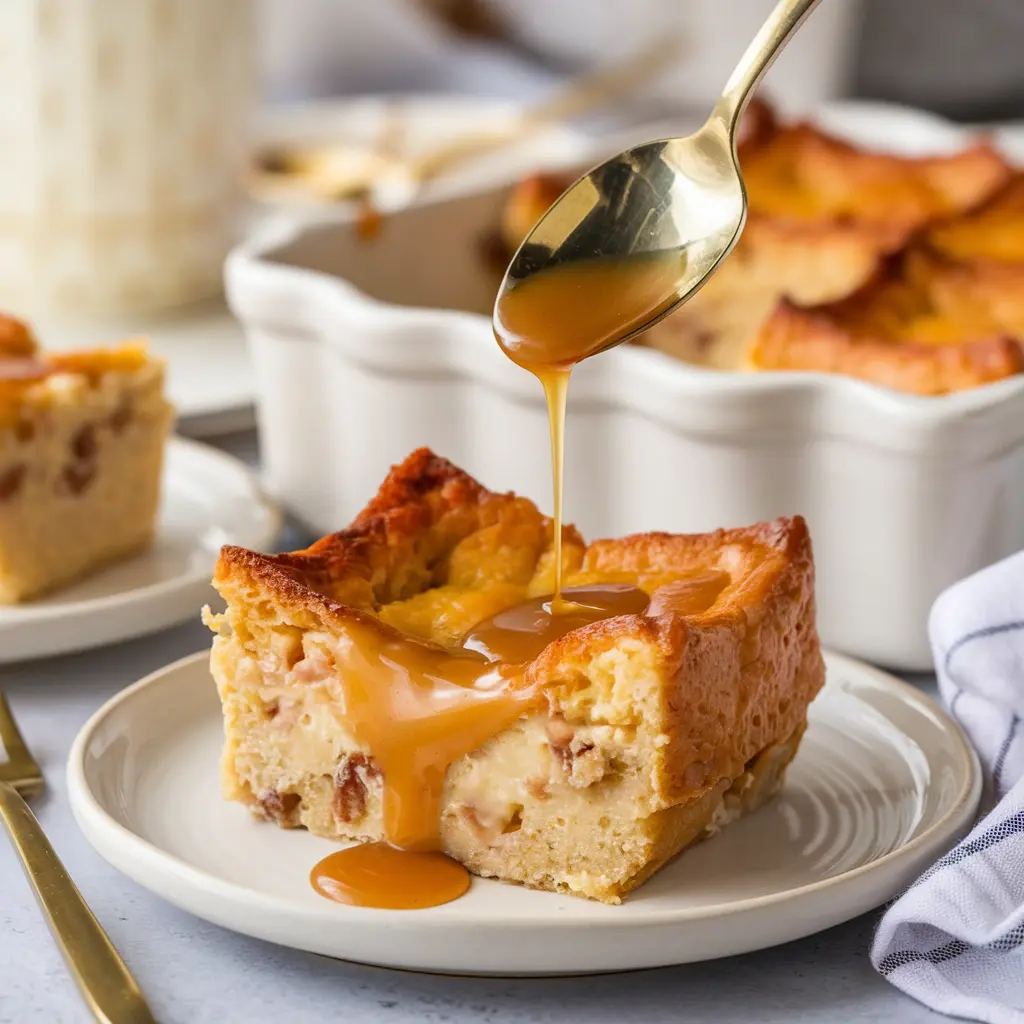Bread pudding recipe is a timeless dessert loved for its comforting texture and rich flavors. Made with day-old bread, milk, eggs, sugar, and spices, it has become a beloved dish across cultures. Whether you’re looking for a sweet treat or a savory delight, bread pudding is versatile enough to satisfy any craving. This article will walk you through everything you need to know to make the perfect bread pudding, from selecting ingredients to serving it like a pro.
Table of contents
What is Bread Pudding Recipe?
Bread pudding is a humble yet indulgent dish made by repurposing stale or leftover bread. Its roots trace back to ancient times when frugality was essential, and wasting food was not an option. This classic dish has stood the test of time, evolving into a gourmet delicacy in many parts of the world.
The History and Evolution of Bread Pudding Recipe
Bread pudding recipe originated in 11th-century Europe as a way to use up stale bread. Known then as “poor man’s pudding,” it combined bread with milk, eggs, and sugar to create a hearty, affordable meal. Over time, its simplicity and adaptability allowed it to cross borders and cultures, becoming a staple dessert in many cuisines. From English custard-based versions to the spiced rum-laden puddings of the Caribbean, each region adds its unique twist.
Why Is Bread Pudding Recipe So Popular?
The popularity of bread pudding stems from its:
- Simplicity: Made from pantry staples, it’s accessible for anyone.
- Versatility: Adaptable to sweet or savory variations, it suits any meal or occasion.
- Comforting Flavor: The warm, custard-soaked bread delivers a nostalgic, satisfying taste.
- Sustainability: Using leftover bread minimizes waste and promotes eco-conscious cooking.
Ingredients Needed
Essential Ingredients for Classic Bread Pudding
To create a traditional bread pudding, you’ll need the following:
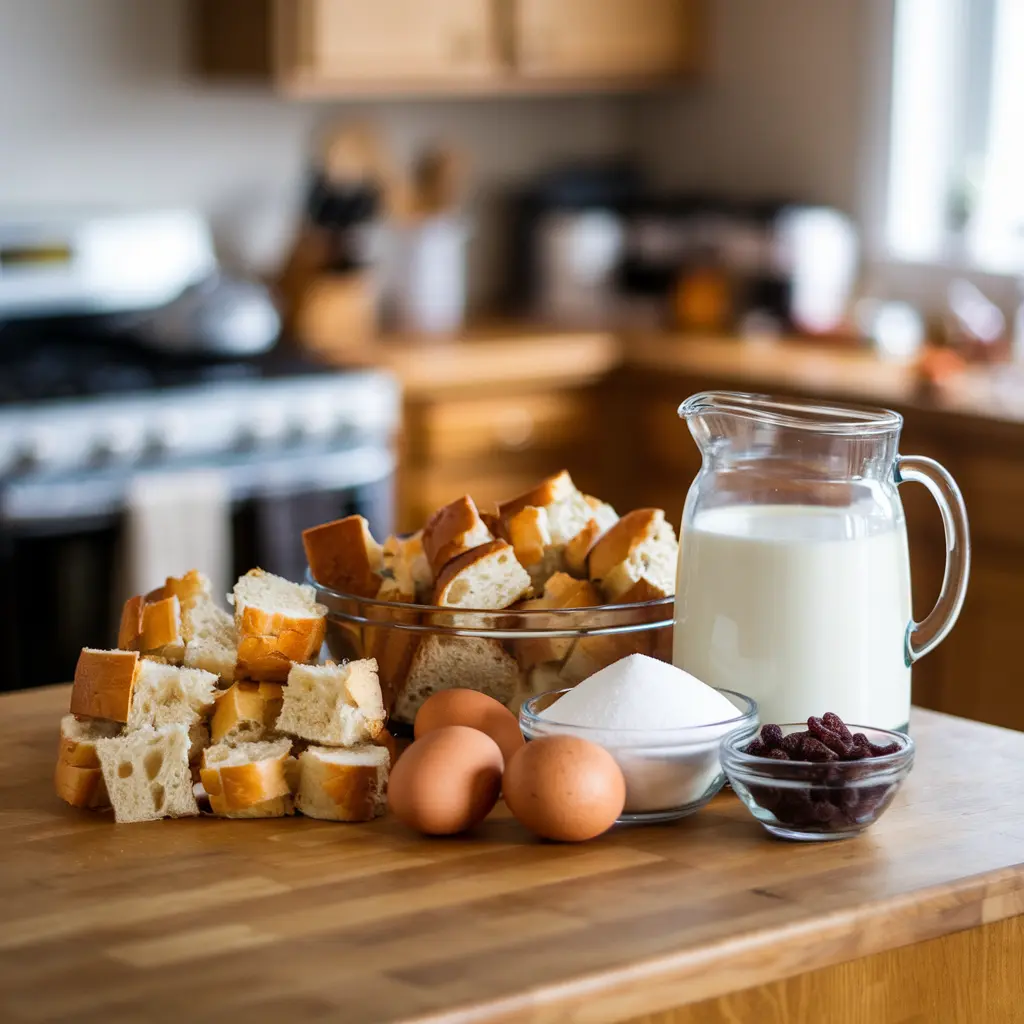
- Bread: Day-old or slightly stale bread, such as brioche, challah, or French bread, works best.
- Milk or Cream: Adds richness and creates the custard base.
- Eggs: Help bind the pudding and provide structure.
- Sugar: Granulated or brown sugar for sweetness.
- Spices: Cinnamon, nutmeg, or vanilla extract for depth of flavor.
- Butter: Adds richness and enhances the texture.
Optional Add-Ins for Extra Flavor
- Fruits: Raisins, cranberries, or sliced bananas.
- Nuts: Pecans, almonds, or walnuts for crunch.
- Chocolate: Chips or chunks for a decadent twist.
- Liquor: Rum or bourbon for a boozy kick.
What is Bread Pudding?
Bread pudding recipe is a dish that transforms simple, leftover ingredients into a decadent and satisfying meal. Its core concept involves repurposing stale bread by soaking it in a custard mixture, then baking it to golden perfection. With origins tracing back to 11th-century England, bread pudding was initially a way to minimize food waste. Over time, it evolved into a beloved dessert that graces menus and homes worldwide.
Cultural Significance of Bread Pudding
From Europe to the Americas and Asia, the bread pudding recipe has taken on regional variations that reflect local flavors and traditions. For instance, in England, it is often spiced with nutmeg and cinnamon, adding a warm, aromatic touch. Similarly, in New Orleans, bread pudding is a signature dessert, typically enriched with bourbon sauce for a bold, rich flavor. Meanwhile, in India, the dish takes on a unique twist, infused with cardamom and topped with nuts, offering a fragrant and crunchy delight. Clearly, this universal appeal highlights bread pudding’s remarkable ability to adapt to different palates and cultural preferences.
Modern Adaptations
While traditional recipes focus on simplicity, modern chefs and home cooks have introduced gourmet twists. Think chocolate bread pudding, savory versions with cheese and herbs, or vegan adaptations using plant-based ingredients. This adaptability ensures that bread pudding remains relevant and exciting.
Ingredients Needed
Crafting the perfect bread pudding begins with selecting the right ingredients. In fact, the beauty of this dish lies in its simplicity, and you likely already have most of what you need in your kitchen. Moreover, using common pantry staples allows for a quick and easy preparation process. For example, items like day-old bread, milk, eggs, and sugar are usually on hand. Therefore, this dessert is not only delicious but also practical for reducing waste and creating something truly delightful. Additionally, the flexibility of the ingredients ensures you can personalize it to suit your taste preferences.
Core Ingredients for Traditional Bread Pudding
- Bread:
The star of the recipe. Stale or day-old bread is ideal as it absorbs the custard mixture without becoming overly soggy. Common choices include:- White bread
- Brioche
- Challah
- French bread
- Milk or Cream:
Provides the creamy base for the custard. You can use whole milk, half-and-half, or heavy cream for a richer result. - Eggs:
Acts as a binder and gives the pudding its signature custard texture. - Sugar:
Sweetens the dish. Granulated sugar is commonly used, but brown sugar adds a deeper, caramel-like flavor. - Spices and Flavorings:
Spices like cinnamon, nutmeg, and vanilla extract enhance the dessert’s aroma and taste. - Butter:
Adds richness and moisture to the dish.
Optional Add-Ins
- Fruits:
Raisins, dried cranberries, chopped apples, or even fresh berries can add bursts of flavor and texture. - Nuts:
Walnuts, pecans, or almonds contribute a pleasant crunch. - Chocolate:
Chocolate chips or cocoa powder are excellent for indulgent variations. - Liquor or Extracts:
Bourbon, rum, or almond extract can add a unique depth of flavor.
Ingredient Variations for Dietary Needs
- Vegan Substitutions:
- Replace eggs with flaxseed or chia seed gel.
- Use almond, soy, or oat milk instead of dairy.
- Substitute butter with coconut oil or margarine.
- Gluten-Free Option:
Swap regular bread for a gluten-free variety. Ensure it’s slightly stale for the best texture.
Step-by-Step Recipe for Bread Pudding Recipe
Making a bread pudding recipe is straightforward and rewarding. To begin with, this classic dessert requires only a few simple steps, making it accessible to both novice and experienced cooks. Furthermore, the process is highly adaptable, allowing you to incorporate your favorite ingredients for a personalized touch. Follow this detailed guide to create a mouthwatering dessert that’s perfect for any occasion. Whether you’re hosting a dinner party, preparing a family treat, or using up leftover bread, this recipe is sure to impress. As a result, you’ll have a comforting, flavorful dish that everyone will love.
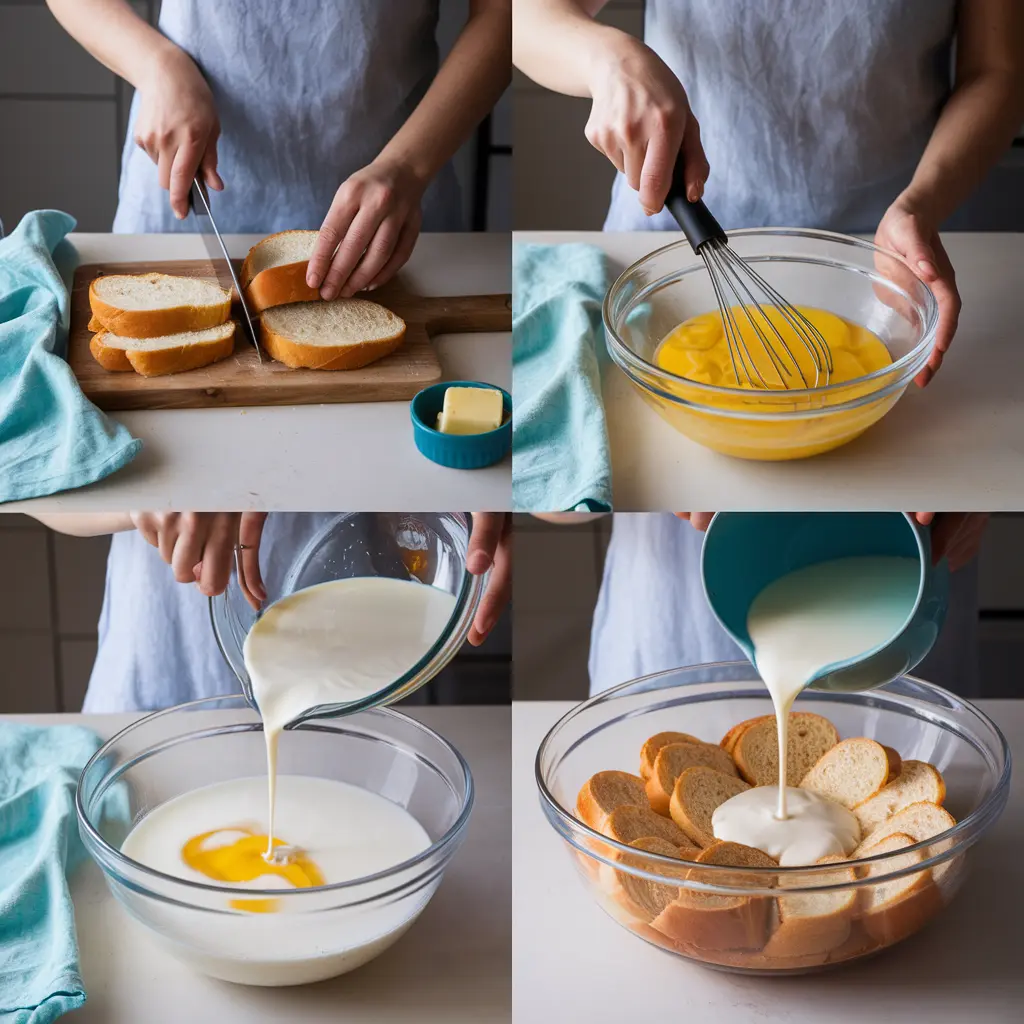
Preparation
- Gather Your Ingredients
Before starting, ensure all your ingredients are measured and ready. This will make the process seamless. - Preheat Your Oven
Set your oven to 350°F (175°C) and grease a baking dish with butter or non-stick spray. - Prepare the Bread
- Cut your bread into 1-inch cubes.
- If your bread isn’t stale, toast the cubes in the oven for 5-7 minutes to help them absorb the custard better.
Making the Custard Mixture
- Combine the Wet Ingredients
- In a mixing bowl, whisk together:
- 4 large eggs
- 2 cups of milk or cream
- ½ cup of sugar (adjust to taste)
- 1 teaspoon vanilla extract
- 1 teaspoon ground cinnamon
- A pinch of nutmeg (optional)
- In a mixing bowl, whisk together:
- Add Butter
Melt 3 tablespoons of butter and whisk it into the custard mixture for added richness.
Assembling the Bread Pudding
- Layer the Bread
Place the bread cubes evenly in your greased baking dish. - Pour the Custard
Slowly pour the custard mixture over the bread, ensuring every piece is saturated. Use a spatula to gently press the bread down so it absorbs the liquid fully. - Add Optional Toppings
Sprinkle raisins, nuts, or chocolate chips on top for extra flavor and texture.
Baking the Bread Pudding
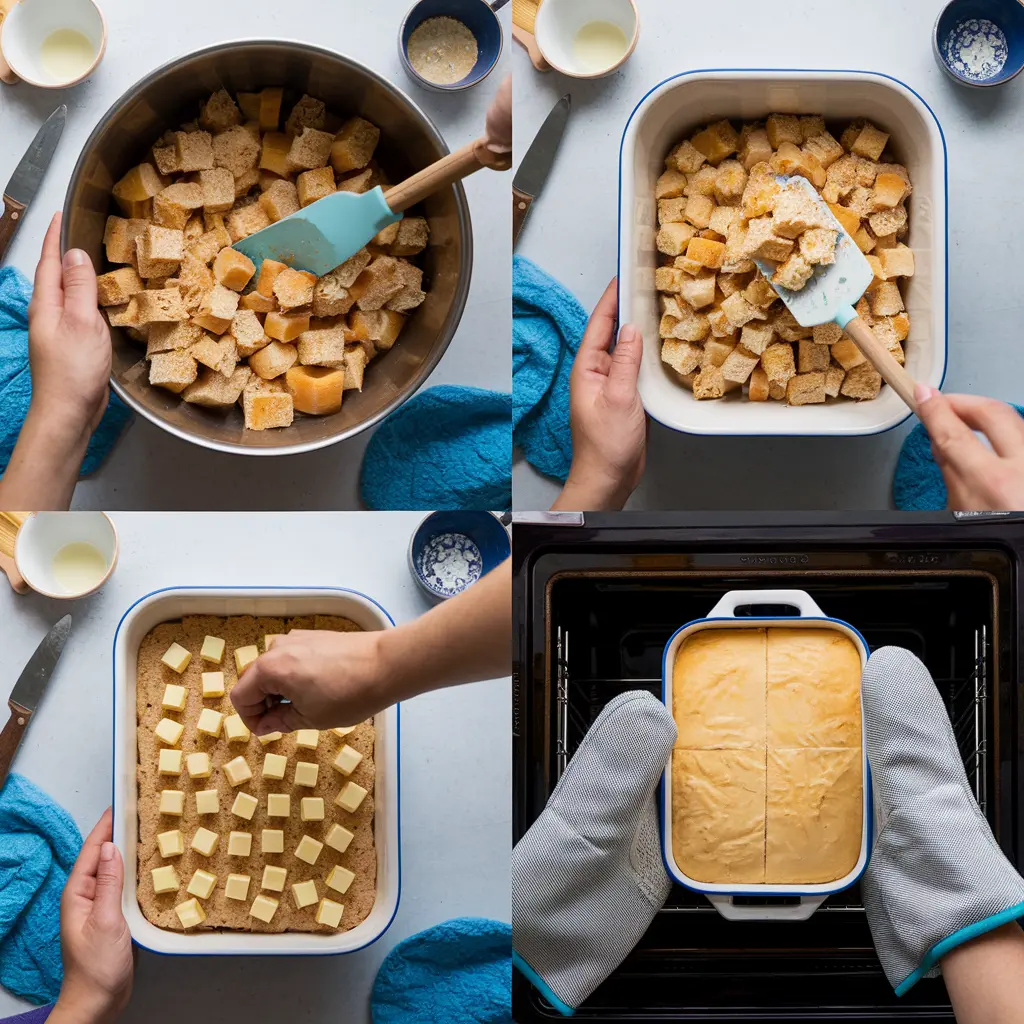
- Cover and Bake
- Cover the dish with aluminum foil to prevent excessive browning.
- Bake for 25 minutes.
- Uncover and Continue Baking
- Remove the foil and bake for another 20-25 minutes, or until the top is golden brown and a knife inserted into the center comes out clean.
- Cool Slightly
Let the pudding cool for 10-15 minutes to set before serving.
Serving Suggestions
Serve the bread pudding recipe warm with your favorite toppings, such as:
- A drizzle of caramel or bourbon sauce
- A dollop of whipped cream
- A scoop of vanilla ice cream
Tips for Success
Mastering a bread pudding recipe is as much about technique as it is about ingredients. For this reason, understanding the right methods can make all the difference. Thankfully, these expert tips will help you avoid common pitfalls and create a dessert that’s perfectly moist, flavorful, and satisfying every time. Moreover, by focusing on both preparation and baking techniques, you’ll ensure a consistently delicious result. In short, with a little attention to detail, your bread pudding will turn out to be a crowd-pleasing masterpiece every single time.
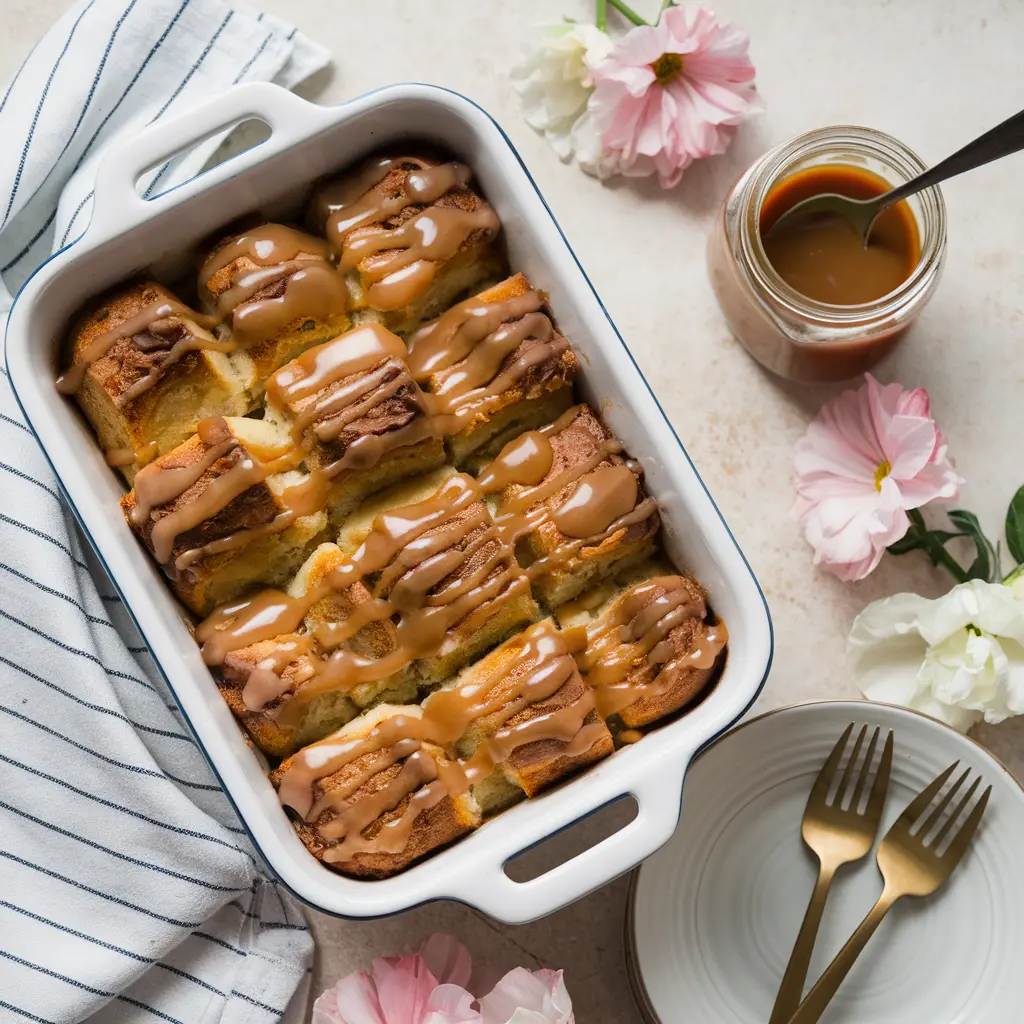
Choosing the Right Bread
- Use Stale or Day-Old Bread
Fresh bread can become too mushy when soaked in custard. Slightly stale bread absorbs the liquid better, giving your pudding the ideal texture. - Experiment with Bread Types
- For a rich and buttery pudding, try brioche or challah.
- French bread or sourdough creates a heartier texture.
- Avoid pre-sliced sandwich bread, as it tends to be too soft.
Perfecting the Custard
- Whisk Thoroughly
Ensure the eggs, milk, and sugar are well combined to create a smooth custard. Lumps can lead to uneven baking. - Sweeten to Taste
Adjust the sugar level based on your add-ins. For example, if you’re using sweet chocolate or fruit, you may want to reduce the sugar. - Infuse Flavors
Enhance the custard by steeping ingredients like cinnamon sticks, vanilla beans, or citrus zest in the milk before mixing.
Assembling the Pudding
- Coat the Bread Evenly
Press the bread gently into the custard to ensure all pieces are soaked evenly. This prevents dry spots. - Allow Resting Time
Let the bread sit in the custard mixture for 15-30 minutes before baking. This ensures maximum absorption and a cohesive texture.
Baking the Pudding
- Monitor the Temperature
Bake at 350°F (175°C) for a consistent texture. A higher temperature can cause the edges to overcook while leaving the center underdone. - Test for Doneness
Insert a knife or toothpick into the center. If it comes out clean, the pudding is ready. If it’s too wet, bake for a few more minutes. - Cover, Then Uncover
Start with aluminum foil to prevent over-browning. Remove the foil during the last 20 minutes for a crispy, golden top.
Storing and Reheating
- Refrigeration
Store leftover bread pudding in an airtight container in the fridge for up to 4 days. - Freezing
Bread pudding can be frozen for up to 2 months. Wrap individual portions tightly in plastic wrap and foil before freezing. - Reheating
- Warm leftovers in the oven at 300°F (150°C) for 10-15 minutes to restore freshness.
- Add a splash of milk or cream before reheating to retain moisture.
Nutritional Information
Understanding the nutritional profile of bread pudding can help you enjoy this delightful dessert as part of a balanced diet. While it is a rich and indulgent treat, small modifications can make it more suitable for various dietary preferences and health goals.
Standard Nutritional Breakdown (Per Serving)
A typical serving of traditional bread pudding (around 1 cup) includes:
- Calories: 290-350
- Carbohydrates: 45-50 grams
- Protein: 7-9 grams
- Fat: 9-12 grams
- Saturated Fat: 4-6 grams
- Fiber: 1-2 grams
- Sugars: 25-30 grams
- Sodium: 150-200 milligrams
Factors Affecting Nutritional Value
- Bread Choice
- Rich breads like brioche or challah increase calorie and fat content.
- Whole-grain bread adds more fiber and nutrients.
- Dairy Options
- Heavy cream raises fat and calorie content.
- Substituting with skim milk or plant-based milk lowers the overall fat content.
- Sweeteners
- Using brown sugar or honey can add trace nutrients compared to white sugar.
- Reducing sugar or using sugar substitutes can significantly lower calorie counts.
Modifications for Healthier Bread Pudding Recipe
- Cutting Calories
- Use low-fat milk instead of cream.
- Reduce butter and opt for healthier alternatives like coconut oil in small quantities.
- Boosting Nutrients
- Add fruits like bananas or berries for natural sweetness and vitamins.
- Mix in seeds or nuts for healthy fats and added protein.
- Reducing Sugar
- Opt for natural sweeteners like maple syrup or stevia.
- Adjust sugar levels to taste, especially if the recipe includes sweet add-ins like chocolate or dried fruit.
Special Dietary Considerations
- For Vegans
- Replace eggs with flaxseed gel (1 tablespoon flaxseed meal + 3 tablespoons water = 1 egg).
- Use almond, soy, or coconut milk instead of dairy milk.
- For Gluten-Free Diets
- Substitute regular bread with gluten-free bread.
- Ensure all other ingredients are gluten-free certified.
- For Low-Sugar Diets
- Sweeten with erythritol or monk fruit instead of sugar.
- Skip sugary sauces and serve with unsweetened yogurt or fresh fruit.
FAQs About Bread Pudding
Bread pudding often sparks questions, especially for those trying it for the first time or looking to perfect their technique. Here are some of the most commonly asked questions, answered.
What type of bread is best for bread pudding?
Answer:
Any bread can work for bread pudding, but sturdy and slightly stale bread absorbs the custard better. Popular options include brioche, challah, French bread, and sourdough. Avoid overly soft or airy breads like sandwich loaves, as they may become too mushy.
Can I make bread pudding ahead of time?
Answer:
Yes! You can prepare the dish ahead in two ways:
- Assemble the pudding and refrigerate it (unbaked) for up to 24 hours, then bake when ready.
- Bake it in advance and store it in the fridge. Reheat in the oven at 300°F (150°C) for about 15 minutes before serving.
How do I prevent bread pudding from becoming too dry?
Answer:
To keep bread pudding moist:
- Ensure the bread is thoroughly soaked in the custard before baking.
- Cover the dish with foil for the first part of baking to retain moisture, then uncover to brown the top.
- Add a splash of milk or cream before reheating leftovers to restore moisture.
Can bread pudding be frozen?
Answer:
Absolutely! Allow the pudding to cool completely before freezing. Wrap it tightly in plastic wrap and aluminum foil, or store it in an airtight container. It can be frozen for up to 2 months. Thaw in the refrigerator overnight and reheat in the oven at 300°F (150°C).
How do I make a vegan version of bread pudding?
Answer:
For a vegan bread pudding:
- Replace eggs with flaxseed gel (1 tablespoon flaxseed meal + 3 tablespoons water = 1 egg).
- Use plant-based milk such as almond, soy, or oat milk.
- Substitute butter with vegan margarine or coconut oil.
Can I make a savory bread pudding?
Answer:
Yes! To make a savory version:
- Omit the sugar and sweet spices from the custard.
- Add ingredients like cheese, sautéed vegetables, cooked bacon or sausage, and herbs.
- Pair with a light salad or soup for a hearty meal.
Conclusion
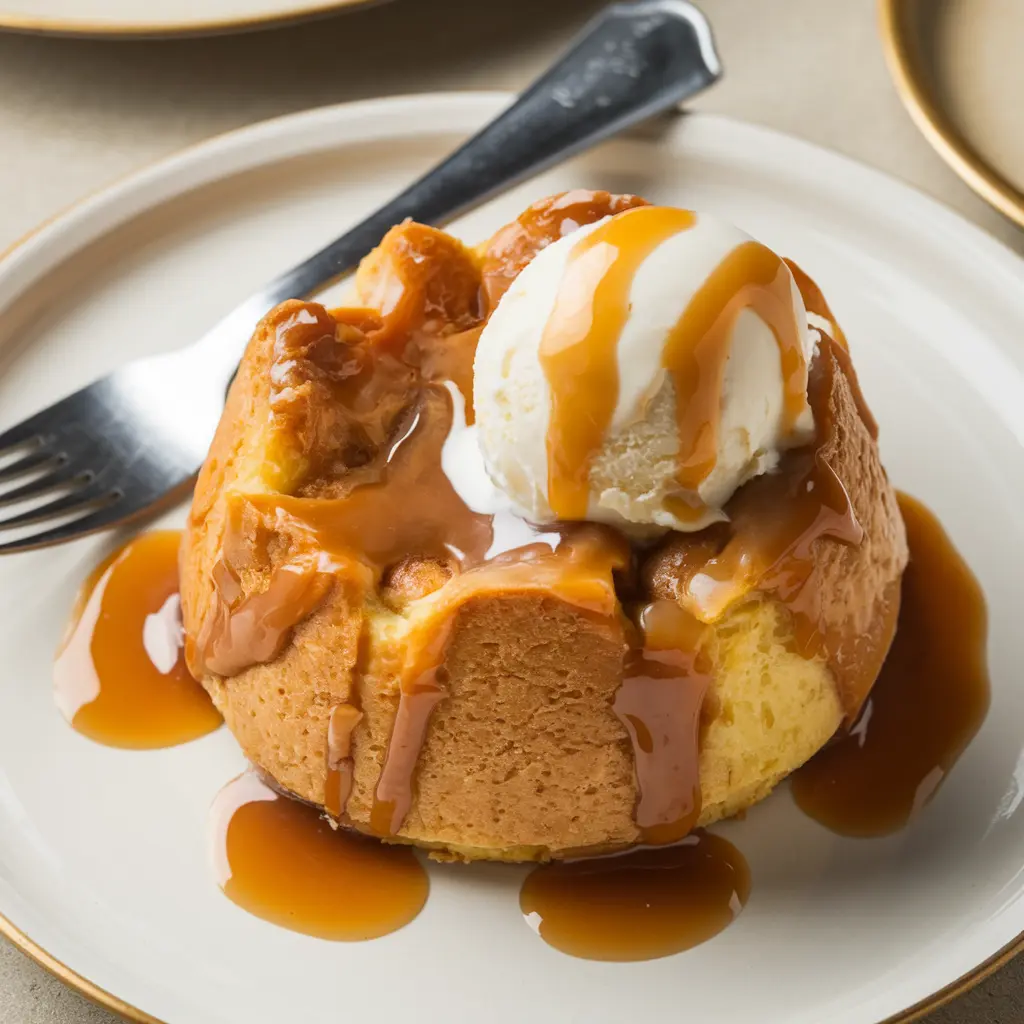
Bread pudding is more than just a dessert; in many ways, it’s a celebration of creativity, comfort, and resourcefulness. Initially, it began as a practical solution to use leftover bread, but over time, it evolved into a cherished treat enjoyed across cultures. Indeed, bread pudding has earned its rightful place in culinary history. What’s more, its versatility allows for endless customization, making it adaptable to suit any occasion, palate, or dietary preference. Ultimately, this beloved dish showcases how simple ingredients can be transformed into something truly special.

